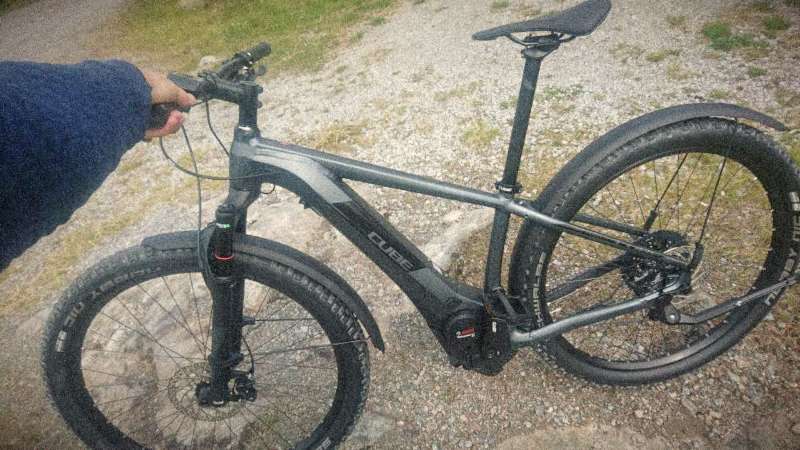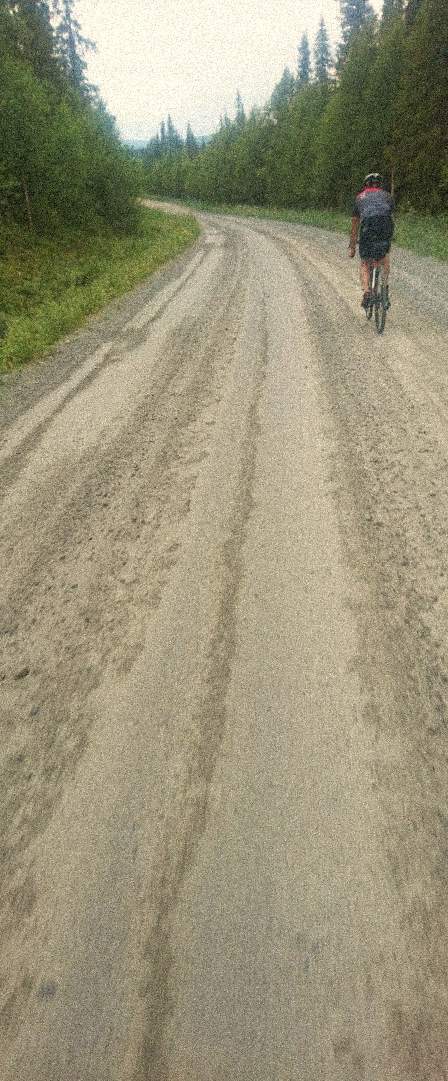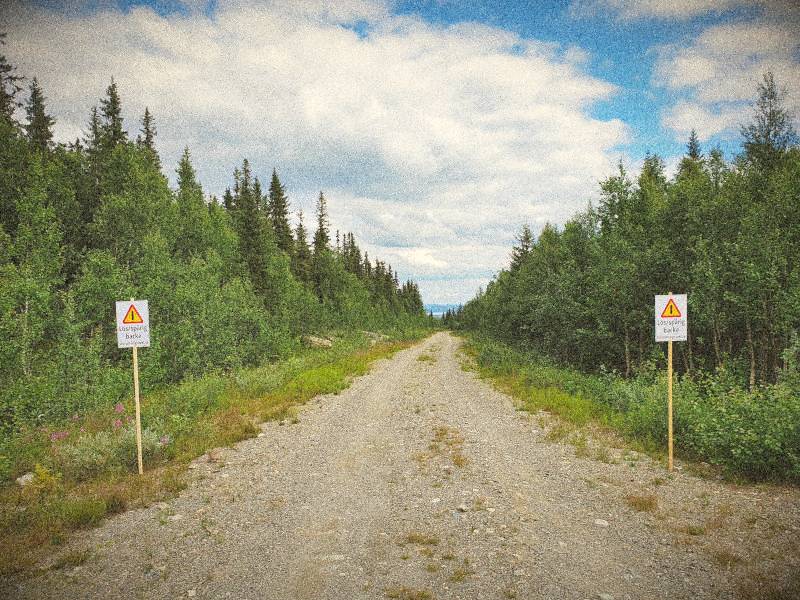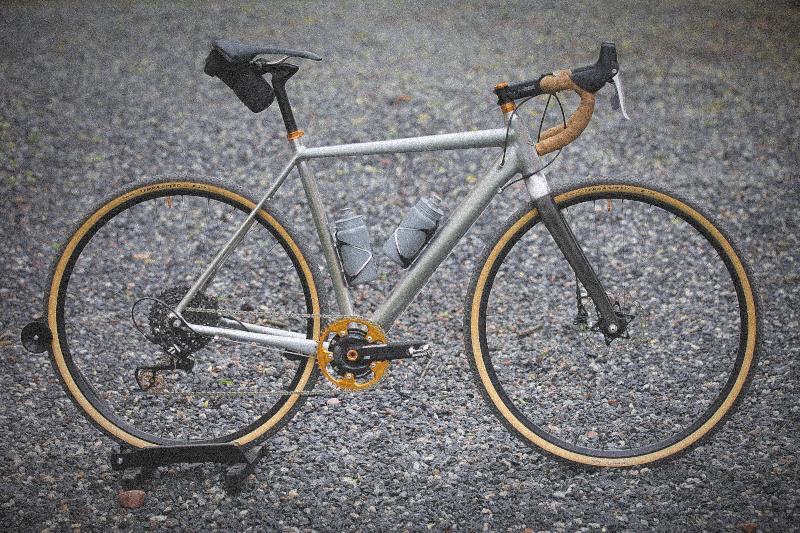Quick info
- Event name: Storuman Gravel.
- Courses: 30, 50, 70, och 116 km. (450 km is a different event, see XL).
- Format: non-competitive bike event, sanctioned by the cycling federation, on gravel roads open for traffic, traffic laws apply.
- Classes: women, men, e-bike and tandem.
- Date: Saturday August 2, 2025.
- Start: 11:00, Ensamheten 9 km outside Storuman (car parking exists).
- Finish: no later than 17:30, same place as the start.
- Registration: 9:30 to 10:45 at the start.
- Service: signposted courses, depots, race timing, livetrack, support car, medic car, toilets at start/finish, shower in Bollhallen Storuman.
Equipment
You will need the following equipment to participate:
- Required: a bike that can be ridden och gravel roads. Aerobars are not allowed.
- Required: a bike helmet.
- Recommended: about 1 liter of liquid and some kind of energy such as sports bars or gels.
- Recommended: equipment to fix a puncture (or two if you tend to have bad luck).
- Recommended: fully charged mobile phone, with the number to the event leader (you get that when you get your number tag).
- Recommended: the Xarepo Live Tracker app installed in the mobile so that the audience and officials can see where you are on the course during the event through our live track feature.
- Recommended: SOS Alarm’s 112 app that helps the emergency service with positioning in the event of a serious accident.
If you want to ride a bit faster, a tire width in the range 35 – 45 mm is best, but wider works of course, and narrower for those who are experienced or ride the easier 30k course.
Speed-loving gravel riders usually have drop bars on their bikes, but it’s in no way required to ride fast. If you have an MTB and want to tune it for gravel, mount a bit narrower and smoother tires and lower the handlebars as the speed is higher and the course is less technical than an MTB course. About half of the bikes in the event are usually MTBs of various kinds, so you will definitely not be alone if you use one.
If you intend to take it a bit easier, it’s fine to ride a regular everyday bike, provided it has a brake on both front and rear wheels (only foot brake is not safe as it becomes disabled if the chain jumps, which might happen when you ride over a bumps in a downhill).
Our sponsor outdoor store Utrustad offers 10% discount for bikes and 20% for bike accessories for participants in Storuman Gravel!
E-bikes


We welcome e-bikes in their own class, as long as they are legal with 25 km/h as the upper limit for motor assistance. Keep in mind that the courses have quite some climbing in them so many e-bikes don’t have battery capacity for more than the 30k course.
Exotic bikes
Unusual bikes such as recumbents and tricycles are also welcome, but then we want you to take it easy, start further back in the field and not ride in a group of regular bikes as they require more space, and visibility to and from these bikes in close riding is often less than good. Also, keep in mind that many of these bikes don’t work particularly well on tougher gravel roads, so use them only if you know how they behave when there’s some loose and uneven ground.
Tandems have their own class that applies regardless of team composition — women / men / mix, two or more.
Bike trailers
It’s allowed to have a trailer attached, but then we ask you to take it really easy and don’t ride in a bunch. Keep in mind that it may become bumpy, especially downhill.
Important for safety
- The roads are open to traffic, traffic rules apply, and cars may appear.
- Several intersections have give way duty, obey the signs!
- Do not take advantage of the situation if someone needs to wait for a car.
- If you ride in a bunch, don’t forget to pay attention to signs and traffic.
- This is a non-competitive event, not a formal race, don’t push it!
There’s very little traffic on the roads so you probably don’t have to wait for a car at an intersection, but if a car actually appears, it’s likely that the motorist is not expecting that a cyclist can appear. Keep in mind that cars are hard, cyclists are soft and you cannot trust that the right hand rule is followed.
Sponsors
Storuman Gravel is dependent on sponsor support. We would like to thank the following sponsors who have made this event possible:
Before and after
Getting here
If you need help finding suitable means of travel to Storuman, we recommend Storuman’s official visitor guide.
Accommodation and food
We have put the start in the middle of the day so those who can get up early in the morning and have a driver can come from far and visit only during the day. Of course, you are welcome to stay longer and there are several different accommodations to choose from within Storuman depending on needs. Again, Storuman’s official visitor guide is a good source of information. There you also get tips of where to eat.
Our sponsor Storuman’s Camping offers a full 30% discount on accommodation for participants at Storuman Gravel. This applies to all types of living, so you can choose from the alternatives available. Register for the event first, and then book via email and write there that you will participate, then you will get the discount.
No post-registration
We do not offer post-registration so you have to sign up in advance. As long as the event is not fully booked this can however be done up to very close to the event here on the web through the signup page.
Start and finish area
The start and finish area is in Ensamheten, 9 km outside Storuman. Ensamheten lacks a permanent parking for these type of events, but we have a temporary solution in place. Drive to Ensamheten as usual, look for a parking sign and then follow the instructions given by the parking attendant. Keep in mind that when you leave the parking with your car, you drive out onto the course where tired cyclists bet on goals. The road is wide enough and it’s uphill for the cyclists so it’s not a problem as long as you are careful.
If you can get a ride and and be dropped off so there will be fewer cars in Ensamheten, that’s great. There is a turning circle inside Ensamheten where it is appropriate to be dropped off and turn the car around.
You can also choose to park inside Storuman and, as a warm-up, cycle to Ensamheten. It’s a scenic 9 km long bike ride on asphalt along the low-traffic Kungavägen that goes next to Storumansjön.
Number tags

Number tags are retrieved at the start (between 09:30 and 10:45). They are needed for the timing and make it easier for the officials to see who is participating and not.
The number tag is of the type that’s put around the seatpost as a flag, visible from the side. This way you don’t have to pin a number to your expensive cycling aparrel or have a large wind catch on the handlebars. The number tag usually fits even if you have a saddlebag, but if it doesn’t work you have to improvise, for example attach it around the top tube or a seat stay.
Timing
Storuman Gravel is a non-competitive event, not a race. We still provide timing so you can see your result afterwards. However, the purpose of the timing is not to single out winners — no place is awarded and there are neither prizes nor podiums. If several riders come in at about the same time, they get the same time in the result. Take it easy out on the course!
As a participant, you can of course ride as fast or slow as you want. The important thing is to follow the traffic laws and stop and give way if necessary, show each other consideration, avoid fighting for positions, and take it easy where the surface is tricky or visibility is limited and cars may appear.
Changing room, shower and toilet
Shower and changing room with toilet will be located in “Bollhallen” in Storuman. The premises are located next to Storuman’s Camping. It will be open 09:00 to 19:00 the day of the event. It’s unattended, so do not leave valuable things there.
At the start and finish area in Ensamheten, there will be portable toilets, but neither a shower nor a changing room.
After finishing
As this is a non-competitive event we don’t have any prizes or ceremony, which means that the rest of the day is free as soon as you arrive at the finish, but do stay and mingle for a while if you like. There's also some refreshments to get.
Your result is announced here on the web.
Social media
It will be great if you use the hashtag #storumangravel when you post things related to the event on social media.
Merchandise
It may of course it be nice to have some physical item as memory from the event, which is why we offer print t-shirts. Instead of letting the registration fee fund a t-shirt in the wrong size and a color you don’t like, we let those who want buy themselves from our online merchandise shop. There’s a large selection of colors, models, sizes and materials, including organic cotton. We have chosen not to have the year in the print so you don’t have to buy one more next year — we want to avoid unnecessary consumption.
The price is the cost of the product and the print, we don’t add anything on top so this isn’t a source of income. If you just want to contribute to the event organizer, we are happy if you just come back again next year and maybe get some more people to come.
Insurance
The event is sanctioned by the Swedish Cycling Federation (SCF), which means that the federation’s group insurance for accidents is included in the registration fee. However, the insurance only applies to the event, so we recommend having your own accident insurance that applies in your free time throughout the year so you have insurance coverage when you train as well.
Out on the course

Cycling in a group
This event is open to everyone, regardless of ambition and experience. Experienced road cyclists know that you can save significant energy and ride faster by cooperating and stay closely together reducing aerodynamic drag. However, keep in mind that your fellow rider may not have much if any experience of group cycling and drafting. Therefore, keep a reasonable distance if you don’t know how experienced the person you are close to is.
If you have not done any group riding before, the most important thing to keep in mind is to not make sudden side movements or brake hard unnecessarily, as there may be cyclists near you who may not react fast enough.
Car traffic
All roads used by the courses are open to car traffic and the traffic laws apply.
The smoother the road, the more traffic. The gravel roads in the mountains are extremely low on traffic so you usually don’t see any car at all, but you still have to keep in mind that behind the crest or around the bend a car might appear so you have to stay to the right. If the visibility is good you can use the entire gravel road, but do so with caution and full awareness of the surroundings.
During the event, it’s likely that there will be more cars out than usual with curious spectators. To you who drive a car out on the course we ask you to be extremely careful and as far as possible avoid driving while the event is on, and if you have to, try avoid driving in the opposite direction, especially in those narrow downhill sections. In some places there will be cars prohibited signs.
Own cars
It is normal for cycling events that only the organizer’s cars are allowed on the course. We don’t have a strict ban, but don’t want you to have companion cars that follow along. However, it is okay to call for your own salvage or repair help if you or your bike breaks down along the course. Make sure that the driver knows the routes so that driving in the opposite direction is avoided. If you go home, do not forget to quit the race first so we don’t think you have gone missing.
Course marking
The course is signposted at all critical intersections so you won’t get lost.
At exits and crossings where you should continue riding straight ahead there are however no directional signs, so it should be said that if you are used to big running competitions with fences and officials who shout, wave and point at each crossing, then an event like this requires the participant to take a little bit more responsibility for the navigation. But, if you just follow the signs and don’t take a turn where there isn’t any, you will come to the finish.

The signs consist of laminated white A3 sheets on sticks. They are quite large, but smaller than regular road signs, so do not forget glasses or lenses if you need them to see clearly.
In addition to signs showing the direction of travel, there are also warning signs for steep downhills, and intersections that require extra attention.
The gravel roads used have virtually no official road signs. To improve safety at the intersections, we have signposted a number of yielding obligations where you as a cyclist must stop if there is a car or other vehicle. There are no pure stop signs and cars are rare so you probably never have to stop, but be prepared! At other intersections, the right-hand rule applies, but do not expect all motorists to follow it — be careful!
There are no signs for each kilometer, so if you want to know how far you have travelled you need to have a cycling computer.
To get an idea of how we have marked the course, you can download the map we use when we place the signs: map with sign placement.
Depots
The depots offer water, a basic energy drink and fruit. The most competitive participants will probably not take the time to stop, but instead carry all the liquid and energy needed for the entire ride on the bike (or have private liquid stations). Even if you plan to ride at a slower pace, we recommend that you bring some water and some energy if you get hungry or thirsty between depots.

For the longest course (70k and 116k, blue and purple in the picture) one depot is used twice. The depot is placed to be in the best position the last time it is passed, which means that if you are thirsty or hungry already at the second depot, you have to ride about 100 meters extra outside the course to reach the depot. It’s signposted.
For the 50k course (yellow line in the picture), this depot is included only once and is located right next to the course.
Trash
At each depot there is a garbage bag where you can dump trash.
It’s of course obvious to most people, but we mention it anyway: it is strictly forbidden to throw waste off the bike. If you accidentally drop a gel wrapper, water bottle or something else, you stop (carefully), turn around and pick up the trash. Being in a fast group in the front is no excuse for leaving the garbage on the ground — it’s a part of riding to be able to hold on to your stuff.
Road surface
The surface of gravel roads varies in a more tangible way than asphalt. After a prolonged period of rain gravel roads can have some more damage and they can be soft making the bike roll slower. Newly maintained gravel roads typically have rougher gravel than usual on top. The roads are usually dry, fast and in relatively good condition, but we cannot give any guarantees.
In parts with steep slopes, it’s common for the surface to be a bit looser and that there is some erosion damage from rain and spring floods. Therefore, if you ride fast, you must have a sharp eye on the ground, especially if you ride with narrow tires.
Punctures and other breakdowns

If you have reasonably fresh tires punctures are rare. The tires can withstand more than you think and the gravel out on the course is generally not that sharp. If you in addition ride at a touring pace the risk of getting a puncture is very low. If you are an experienced cyclist who can repair a puncture in the field, we still recommend that you bring repair equipment just like you would on a regular long ride.
Since the event welcomes everyone regardless of experience, we don’t expect everyone to be experts at fixing a puncture or other breakdowns in the field, so if you don’t have any repair kit or don’t know the craft, we think it’s okay, and we want you to come and ride anyway. Most likely it will go well without a mishap. If you don’t carry a repair kit we recommend that you do not choose the longest course (116k) though.
If you do get bad luck and get stranded on the course with a broken bike, then some patience is needed. We have an assistance car but the course is long and it can take some time for the car to reach you. If you have a friend who can pick up or repair it’s okay, but if car is driven to the site the driver should be very careful and if possible avoid driving opposite to the course direction.
It’s allowed to receive repair assistance from outside or swap the bike and then continue the event from the same place (or where you went by foot to have the bike repaired or replaced).
Quitting the event
If you need to quit the event then notify the event leader by phone or at a depot or finish. To make it easier for the officials and the timing, remove the number tag and don’t ride in over the finish line.
It’s important that you let us know if you are going home before you reach the finish line because we keep track of everyone to make sure that no one gets lost. If someone is missing, we need to do a search out on the course.
Injuries
Participation is at your own risk. The Swedish Cycling Federation’s accident insurance is included in the registration fee, but it only applies during the event itself, so if you want coverage during training before the event, you need to get your own.
We recommend that you bring a mobile phone so you can call for help in the event of an emergency. The mobile phone can also be used for positioning if you cannot describe where you are, and for that SOS Alarm’s 112 app is an excellent companion.
As a participant, you are obliged to stop and help if someone needs emergency assistance due to injury or illness.







